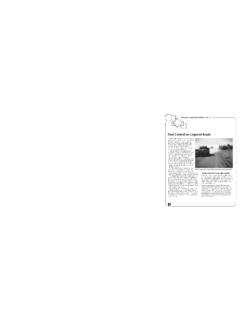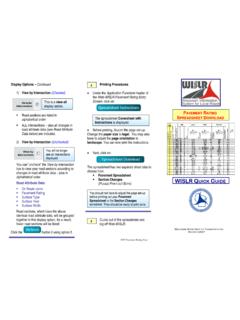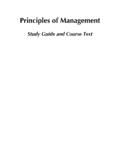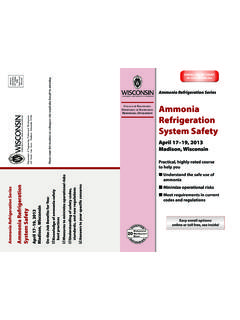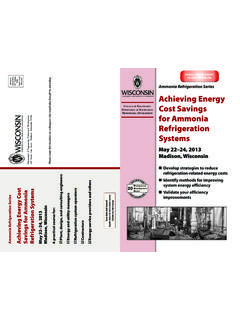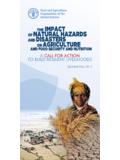Transcription of Natural Hazards: Causes and Effects - Mac OS X Server
1 Natural hazards : Causes and Effects Study Guide and Course Text Natural hazards : Causes and Effects Study Guide for disaster Management Prepared by Don Schramm and Robert Dries To be used in conjunction with Natural hazards : Causes and Effects Course Text UW-DMC. disaster Management Center University of Wisconsin-Madison This publication was prepared by the disaster Management Center at the University of Wisconsin- Madison with financial support from the Office of Foreign disaster Assistance, United States Agency for International Development (OFDA/USAID). This report was prepared by the University of Wisconsin (UW). Neither the UW nor any of its officers or employees makes any warranty, express or limited, or assumes any legal liability or responsibility for the accuracy, completeness, or usefulness of any information, apparatus, product, or process disclosed, or represents that its use would infringe privately owned rights.
2 Reference herein to any specific commercial product, process, or service by trade name, mark, manufacturer, or otherwise, does not necessarily constitute or imply its endorsement by the UW. Copyright 1986 by University of Wisconsin Board of Regents All rights reserved. Produced by the University of Wisconsin Madison Manufactured in the United States of America For permission to reprint, contact: disaster Management Center University Of Wisconsin-Madison Engineering Professional Development 432 North Lake Street Madison Wisconsin 53706 USA. 608-262-5441. If you need this material in an alternative format, please contact the program coordinator or the Office of Equal Opportunity and Diversity Programs.
3 Direct policy inquiries to the Office of Equal Opportunity and Diversity Programs, 501 Extension Building, 432 N. Lake Street, Madison WI 53706. Acknowledgments The disaster Management Center at the University of Wisconsin Madison thanks the Office of Foreign disaster Assistance for early support of course development. In particular, Gudren Huden, Denise Decker and Fred Cole deserve special recognition for their understanding of this innovative educational process. At the University of Wisconsin, Linda Hook, Darrell Petska, Kate Olle, and Kristen Baer must be thanked for their efforts in preparing and editing the manuscript; and at Artifax, Susan Kummer and Val Parish for layout and typesetting.
4 The course development process is never over, and each of these people understands that very well. Introduction How to Get Started This self-study course will meet the needs of people involved in managing both sudden- onset Natural disasters ( , earthquakes, floods, hurricanes) and slow-onset disasters ( , famine, drought). This course is designed for government personnel, representatives of private voluntary agencies and other individuals at local and national levels who are interested in disaster management. The procedure for self-study is: Complete and score the pretest. Do not be disappointed if you have a low score. If you have a high score, you probably do not need this course.
5 Read the outline of course content to get a general idea of what is covered in the course. Read the learning objectives to get a general idea of what you are expected to learn from the course. Turn to Lesson 1: Introduction to Natural hazards Review the study guide section for a brief description of the lesson and any special suggestions on how to study. Again read the learning objectives. Carry out the learning activities listed. Complete the self-assessment test at the end of the lesson and score it using the answer key provided. If you have not answered most of the questions correctly, restudy the lesson. If you score well on the self-assessment test, proceed to Lesson 2.
6 Continue to study each lesson and complete the self-assessment test until you have finished the course of study. When you have completed to your satisfaction all the self- assessment tests, you can request a final examination package. This will include the final examination and any other supplementary material. Pretest Multiple Choice b) tidal floods Circle the best answer(s): c) very heavy rainfall d) agricultural soil erosion 1. The best foreign relief to an earthquake- e) countercurrents beneath the ocean's stricken area is: surface a) cash 7. The first step in desertification of b) food, blankets and clothing rangelands is: c) medical assistance a) thinning of vegetation due to grazing d) teams of assessment workers and b) severe drought other volunteers c) an increase in edible perennial plants e) long-term recovery assistance d) water runoff due to sun-hardened soil e) an increase in groundwater level due to 2.
7 The largest annual death toll during the runoff 1970s was caused by: a) floods 8. Tsunamis may strike with a force: b) earthquakes a) greater than other types of disasters c) tropical cyclones b) that radically alters the landscape d) drought c) that affects only lands along the world's e) all other disasters oceans d) that seriously disrupts economic and 3. The majority of volcanoes are located in: social patterns a) the circum-Pacific belt e) all of the above b) the mid-Atlantic line c) East Africa d) the African Rift Valley 9. The major human-made cause of e) Hawaii deforestation today is: b) fuel c) wood pulp for papermaking 4. Active floodproofing is most effective: d) unequal land tenure a) with long warning lead times e) farming b) in flash flood areas f) none of the above c) if it is permanent d) in floodplain areas e) using volunteers True or False 5.
8 Supplementary feeding programs are: Indicate T or F: a) targeted to those people suffering from severe protein-energy malnutrition _____ 10. The ingredients of cyclones are a (PEM) mixture of heat and moisture. b) targeted to those people suffering from moderate PEM _____ 11. A Natural event such as an c) often used to distribute general food earthquake will always result in a rations over a wide geographic area disaster . d) of little value in large-scale famine relief operations _____ 12. An underwater earthquake in the e) a secondary response best handled by ocean near your area is a Natural foreign agencies tsunami warning. 6. Tropical cyclones often generate: _____ 13.
9 A secondary effect of a volcanic a) high rates of injured people eruption may be the saturation of ash with rain, causing roofs to collapse. _____ 14. Current international warning systems issue a cyclone warning . when a cyclone could reach land within 24 hours. _____ 15. The rapid rate of deforestation is a prime force in the yearly increase of flood disasters in the tropics. _____ 16. Flash floods are rare in deserts and mountains. _____ 17. Lands threatened by desertification cover 10 percent of the world's surface. _____ 18. Communicable diseases are a major threat after an earthquake. _____ 19. Drought will occur only in semiarid climates.
10 _____ 20. The largest flood-related losses take place in countries with agricultural economies. Answer Key 1. a 2. b 3. a 4. a 5. b 6. c 7. a 8. e 9. e 10. T. 11. F. 12. T. 13. T. 14. F. 15. T. 16. F. 17. F. 18. F. 19. F. 20. T. Outline of Content Historical Examples and Geographical Lesson 1 Introduction to Natural Distribution hazards Forecasting, Warning, and Monitoring Classification of Disasters Systems Phases of a disaster Impact on Built and Natural Effects of Disasters Environments Prevention, Mitigation and Mitigation Strategies Preparedness Lesson 7 Drought Lesson 2 Earthquakes Historical Examples and Geographical Historical Examples and Geographical Distribution Distribution Natural Preconditions for Drought Effects of Earthquakes Impact of Droughts Earthquake Forecasting Famine Impact of Earthquakes Mitigation Strategies Pre- disaster and Post- disaster Post- disaster Activities Activities Lessons Learned Lessons from Past Disasters Lesson 8 Desertification Lesson 3 Tsunamis Historical Examples and Geographical Historical Examples and Geographical Distribution Distribution Natural and Human Preconditions Impact on Natural and
